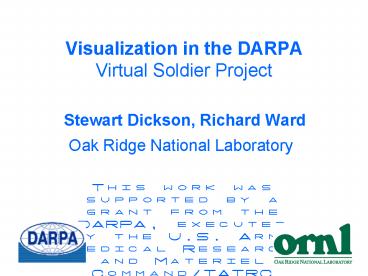Visualization in the DARPA Virtual Soldier Project - PowerPoint PPT Presentation
1 / 36
Title:
Visualization in the DARPA Virtual Soldier Project
Description:
P-Tag, CODEC, Holomer Display & HotBox (Holographic Stereo Display) 2. Statistical Reasoning ... (Holographic Stereo Display) 5. P-Tag, CODEC Data Flow -- CDR. 6 ... – PowerPoint PPT presentation
Number of Views:102
Avg rating:3.0/5.0
Title: Visualization in the DARPA Virtual Soldier Project
1
Visualization in the DARPAVirtual Soldier Project
- Stewart Dickson, Richard Ward
- Oak Ridge National Laboratory
- This work was supported by a grant from the
DARPA, executed by the U.S. Army Medical Research
and Materiel Command/TATRC Cooperative Agreement,
Contract W81XWH-04-2-0012.
2
Collaborators
- University of Michigan/Center for Biological
Information - University of California, San Diego
- University of Washington
- Crowley-Davis Research
- University of South Carolina
- University of Utah
- Oak Ridge National Laboratory
3
Virtual Soldier Phase I Demo
- P-Tag, CODEC, Holomer Display HotBox
(Holographic Stereo Display) - 2. Statistical Reasoning
- Backward from Effect to Cause
- 3. Multi-Scale Modeling
- Physiologic Predictive Model
- 4. Causal Reasoning
- Forward from Cause to Effect
4
Part 1
- P-Tag
- 2 Gigabytes Baseline Medical Data
- CODEC
- Automatic CT Volume Segmentation
- Holomer Display
- HotBox
- Interface to Virtual Soldier Knowledge Base
- (Holographic Stereo Display)
5
P-Tag, CODEC Data Flow -- CDR
6
Imaging and Segmentation -- GE
7
Imaging and Segmentation -- GE
8
Imaging and Segmentation -- GE
9
Imaging and Segmentation -- GE
10
Virtual Soldier Knowledge Base
11
Holomer Display -- Utah/ORNL
12
Holomer Display -- Utah/ORNL
3-D Cursor
13
HotBox -- ORNL
14
HotBox -- ORNL
15
HotBox Data Sources
- Anatomical Labels from Segmentation
- Adjacency Relations from Segmentation
- Entity Bounding Boxes from Segmentation
- Injury List from Causal Reasoning
- Surface Geometry from Segmentation
- Physiological Data from HIP Simulation
- Foundational Model of Anatomy
16
HotBox User Feedback
- Highlights Selected Tissue in 3-D Anatomy
- Updates Adjacent Tissues to Selection
- Updates Structural Relationships to Selection
- Alerts to Injured Tissue
- Visually Indicates Probability of Injury
- Dynamically Displays Physiological Data
- Associated with Selection
17
Part 2 Statistical Reasoning
- Backward from Effect to Cause Using
- Automatic CT Scan Segmentation and Labeling
- Morphometric Markup
- High-Integration Parameter Simulation (HIP)
- Virtual Soldier Knowledge Base (VSKB)
- Forecast Survival or Time to Death
- Estimate Injury Location Severity
18
Statistical Reasoning Data Flows
19
Decision Space Display -- U. Michigan
20
Probable Injury Display
21
Part 3 Multi-Scale Modeling
- Anatomical and Physiologic Predictive Model
- Circulatory physiology combined with
- Anatomically and Biophysically detailed
- 3D Models of Ventricular Electromechanics
- Model physiological signals not measurable in the
field - Database covers more cases than possible with
experimental data alone
22
Multi-Scale Modeling Data Flows
23
Material Point Method -- Utah/UCSD
24
MPM Cardiac Penetration Trauma
25
EdgeWarp -- University of Michigan
26
EdgeWarp -- University of Michigan
27
Part 4 Causal Reasoning
- Help the Medic make Triage Decisions
- Given two anatomically similar wounds
- Reason from Cause to Effect
- Deduce Differences in Pathological
- Consequences
- Simulate Differences in Pathophysiological
- Outcomes
28
Causal Reasoning Data Flows
29
Simulated Cardiac Wound - Strain
30
Simulated Cardiac Wound - Pressure
31
Highly Integrated Physiology (HIP)
Models Available at http//nsr.bioeng.washington.
edu
32
Physiology Data Display -- U.Mich.
33
Causal Reasoning -- U. Washington
34
Foundational Model of Anatomy
35
Coronary Circulation Simulation
36
Bullet-Proof Heart -- UCSD/Utah































